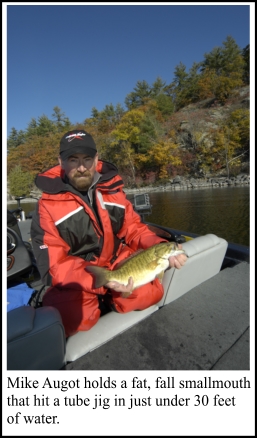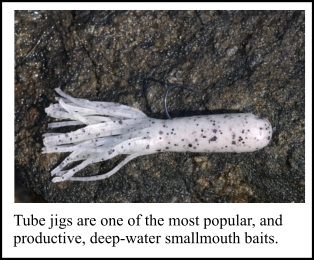Deep-Water Jigging
for Smallies
By Tim Allard
The fall colours were in full
effect, dotting the shoreline on a crisp, October morning. I was fishing
for deep-water smallmouth around rocks and boulders in 20-30 feet of
water. I jiggled my tube jig along, paused, and then felt a slight tick. I
set the hook and the fight began. The three pound smallie bulldogged for a
few minutes, but eventually got in net range and was landed. After the
hook was popped out, the chunky specimen swam away strongly after being
released.
 Fall
Location Fall
Location
It's no secret that come fall and cool water temperatures, smallmouth move
deeper. Often in concentrated numbers, smallies can be found on transition
areas close to the main basin. These brozeback bruisers are feeding in
preparation for the winter, so look for rock and boulder areas, wood, and
sometimes sand on reefs, points and spines. These areas provide a mix of
good spots for smallies to corner and ambush baitfish but will also often
hold crayfish. Use a hydrographic map or GPS unit to quickly locate these
off shore areas. With reliable sonar, you should easily be able to mark
smallies as you pass over these spots.
Good Fall Baits
When aggressively feeding, smallies will hammer a lot of baits. An
excellent choice for deep-water are jigging spoons. You can cast these
baits out or vertical jig them. Either way, rip these baits to rise them
off bottom and then let them drop. When smallies are wound up and feeding,
the strikes are phenomenal.
For a more subtle approach,
consider natural coloured grubs and tube jigs. Work these baits along the
lake bottom, crawling them in and around boulders. I prefer a vertical
jigging approach as opposed to casting to cover deep water. With the bait
directly below me, I rely on my trolling motor to slowly move the boat so
I can methodically pick apart the underwater structure. I have found that
raising the bait, quivering it, and then pausing before letting it fall to
the bottom can be an excellent trigger for reluctant smallmouth when
vertical jigging.
 Of
course, another excellent tactic is dropshotting. Finesse tubes, minnows,
or stick baits will all take smallies on a drop shot rig in the fall.
Remember that when working these baits, less is more. The key is picking a
plastic that will still look lively when you lightly shake the line,
without moving the sinker along the bottom. Often, these minute vibrations
are hard for fish to ignore. Of
course, another excellent tactic is dropshotting. Finesse tubes, minnows,
or stick baits will all take smallies on a drop shot rig in the fall.
Remember that when working these baits, less is more. The key is picking a
plastic that will still look lively when you lightly shake the line,
without moving the sinker along the bottom. Often, these minute vibrations
are hard for fish to ignore.
Line and Snags
If you fishing with monofilament in deep water, you're at a major
advantage as you need sensitivity to deep-water jig effectively. You want
to use low-stretch line and this is where superbaids reign supreme. I tie
a two to three foot leader of fluorocarbon to braid and use a blood knot.
With the leader, I can easily break off if I get snagged.
That said, if you're finesse
fishing and slowly covering water, you shouldn't snag too often. Key to
avoiding snags is not setting the hook when you get hung up. It takes some
time to get a feel for it, but after a few hours deep-water jigging you'll
learn to discern between strikes versus underwater obstacles. When you do
find yourself snagged, try using the "bow and arrow" method. This is done
by pulling grabbing the line just above the reel, pulling it out (to bend
the rod) and then letting it snap back. The quick snap of the rod tip can
often cause baits to pop out of snags.
Sensitive, Balanced Rods and
Reels.
For deep-water jigging, I prefer a spinning rod. Critical to feeling
deep-water strikes are sensitive rods that are properly balanced with a
high quality reel. I like a fast action rod with a sensitive tip. Don't
confuse sensitivity with too flexible a tip. These flimsy ends are not
meant for sensing light strikes. Yes as much as strikes can be subtle, the
fight can be furious and this is where a reel with a quality drag is
critical to landing fish.
Catching fat, smallmouth bass on
a crisp autumn day is one of my favourite fishing experiences. It can take
some time to find smallies on an unfamiliar lake, but once you do the
action is often worth the wait. Give this approach a try this fall and get
a few more weeks of open water fishing in before the ice season starts.
|


 Fall
Location
Fall
Location Of
course, another excellent tactic is dropshotting. Finesse tubes, minnows,
or stick baits will all take smallies on a drop shot rig in the fall.
Remember that when working these baits, less is more. The key is picking a
plastic that will still look lively when you lightly shake the line,
without moving the sinker along the bottom. Often, these minute vibrations
are hard for fish to ignore.
Of
course, another excellent tactic is dropshotting. Finesse tubes, minnows,
or stick baits will all take smallies on a drop shot rig in the fall.
Remember that when working these baits, less is more. The key is picking a
plastic that will still look lively when you lightly shake the line,
without moving the sinker along the bottom. Often, these minute vibrations
are hard for fish to ignore.